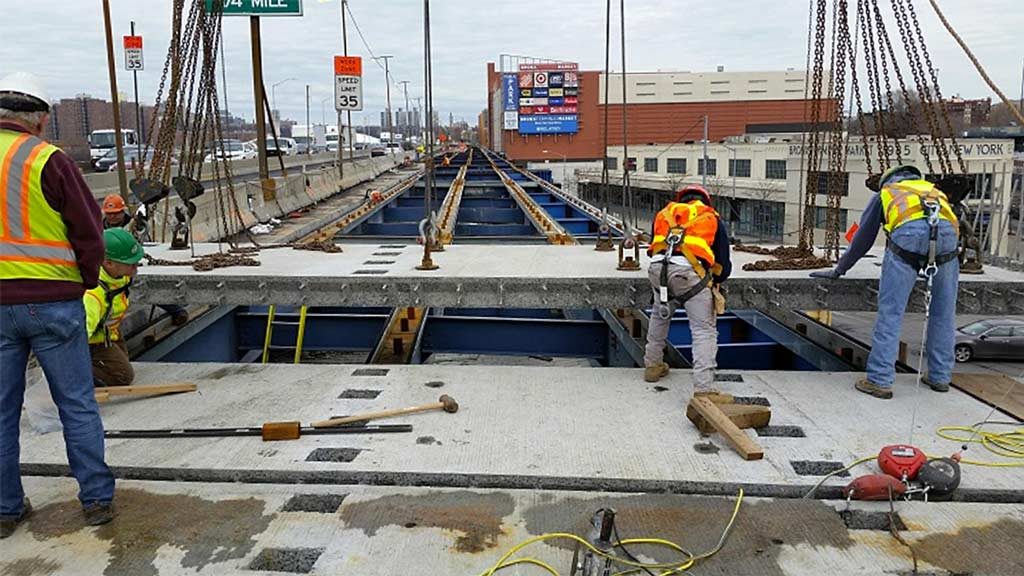Although ultra-high-performance concrete (UHPC) has been used mostly for bridge infrastructure projects in North America, it is gaining popularity around the world for other structural engineering and architectural applications, said Gregory Nault, project manager, UHPC engineering, LafargeHolcim.
Nault hosted the session UHPC 20 Years Later, at the Canadian Concrete Expo Jan. 22 in Mississauga, Ont. LafargeHolcim is a supplier which produces the UHPC product Ductal.
UHPC is an advanced cementitious composite, fibre-reinforced material with significantly improved strength, durability and ductility when compared with conventional concretes.
“That particle packing behaviour is what makes it unique,” said Nault. “Concrete generally deteriorates by stuff getting in it and damaging it from the inside. If water and salt can’t get into your material, then you have a much more robust material that can last for a much longer period of time. This is the whole premise of UHPC and one of the reasons why a lot of folks are starting to pay a lot more attention to it.”
It is being used in bridge projects to speed up the construction, improve long-term service life and reduce future maintenance and rehabilitation needs and associated costs.
Much of the bridge and interstate infrastructure in the U.S. was built in the 1950s and 60s with a service life of about 50 years.
“The U.S. is facing a problem where we have a lot of bridges that need TLC and they would rather do some form of rehabilitation than full replacement,” said Nault.
“What is very clear is we can expect close to 100 years of service life using a true UHPC material… Arguably the most important attribute of UHPC is its durability. It is far and beyond any other concrete product you work with.”
In the presentation, Nault highlighted the provinces and states that have adopted UHPC details for Accelerated Bridge Construction projects.
It has better strength it has higher tension capacity than most other concretes,
— Gregory Nault
LafargeHolcim
One of the first applications in North America was on a pedestrian bridge in Sherbrooke, Que. in 1997. Uptake in the early years was slow but there has been more momentum in the last decade.
“To our knowledge there was a lot of activity in Canada leading up into 2015 in which northwest Ontario was using a lot of this technology to replace some of its bridge superstructures but then following 2015 we haven’t seen near the same amount of the projects,” said Nault.
“The U.S. is a different story… A lot of states are getting familiar with the technology, understanding what benefits it brings to their infrastructure and doing a lot of pilot projects to figure out how they can successfully use it.”
Iowa embarked on several projects using UHPC starting in 2008 including designing a waffle-shaped slab system. By doing this they were able to cut out about 40 to 50 per cent of the material that would otherwise have been needed in a solid full slab system.
“Because it has better strength it has higher tension capacity than most other concretes, we can start redefining shapes of structural elements that can carry the same amount of load,” Nault explained.
In 2012, Thunder Bay, Ont. used UHPC in a few different ways including as a shell to cover columns on road projects.
“They wanted to have a really permeable material on the outside, so they used UHPC for the shell,” said Nault. “They also made a precast pier cap above the columns and cast that entirely out of UHPC. What they found by doing that and having a stronger concrete in that area is they could reduce the foundation from four columns down to three columns which looked better esthetically and was less construction for the contractor.”
UHPC can also be used to replace decking and leave the substructure in place, assuming it’s in good condition, Nault said.
“What they came up with is this idea of using precast deck panels made of high-performance concrete, precast in a yard or adjacent to the bridge then brought onto the bridge and installed on to the existing superstructure element,” Nault stated. “By putting UHPC in the joints, it connects everything together.”
“It’s a way to prolong the life of a structure that is otherwise in good condition, it just needs some fixing up,” he added.
One of the newer ideas starting to emerge in the U.S. which stems from work being done in Europe is to use UHPC as a complete overlay system on a bridge.
“Rather than replacing the entire thickness of deck…removing the top 50 mm or so of cover concrete and building back that top layer with a very durable UHPC layer,” explained Nault.
“The Federal Highway Administration is looking at this solution as a way of preventing us from having to go full deck replacement which is time consuming, costly, disruptive to traffic. This is an avenue that is emerging right now in the market.”
UHPC can also be textured and coloured which creates unique elements for buildings, Nault said.
Follow the author on Twitter @DCN_Angela.










Recent Comments